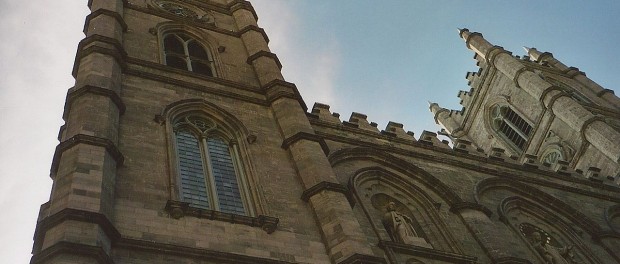The Notre Dame Rip-off & Other Quebec Curios
Each day at each beginning of the hour, a crowd gathers at Basilique Notre Dame to hear the bells ring. The crowd stands, transfixed with wonder as the carillon bells chime, its tune heard for blocks away. Then, as soon as it ends, the crowd disperses, strangers once more. Yet perhaps it would be somewhat surprising that this Basilica, despite its architecture, does not belong to the 1600s but the 1800s. It is young compared to its fellow churches.
The site of the Basilica originally contained a small chapel run by the Jesuits. After the Sulpicians arrived in the mid-1600s, one of their own, François Dollier de Casson, decided that there needed to be a bigger, better church and built his own. It was at that point that Notre Dame road was first paved and came into regular usage. The building remained in good usage as the congregation grew, but one day in the 1800s, there was just one person too many, and the church decided it once again needed a makeover.
It really isn’t a Notre Dame Cathedral rip-off, it just looks very similar. Jokes aside, the two churches, however, belong to different times and different architectural styles. The Basilique Notre Dame, designed by architect James O’Donnell, belongs to the Gothic Revival tradition, whereas Paris’ Notre Dame Cathedral belongs to the true Gothic tradition, French-style. Construction of the outer part of the cathedral began in 1824. Its interior was only completed in 1879.
The Basilica remains part of the collective memory of many, and shows the Basilica’s various uses: it was used for the funeral of former Prime Minister Pierre-Elliot Trudeau as well as sports superstar Maurice Richard, as well as happier events such as Celine Dion as well as its sound and light shows outside the building and its annual Christmas performance of Handel’s Messiah. As a tourist destination, it charges five dollars as an admission fee except for pilgrims or people going to mass. The Basilica contains various works of religious art going back as far as the 17th century.
And yet perhaps the strangest thing in this story is that its original designer, O’Donnell, wasn’t Catholic at all. The Irishman was an Anglican throughout his life, and it was only as he lay dying that he decided to take the leap of faith and become Catholic. He is the only person buried in the crypt of his own cathedral.






